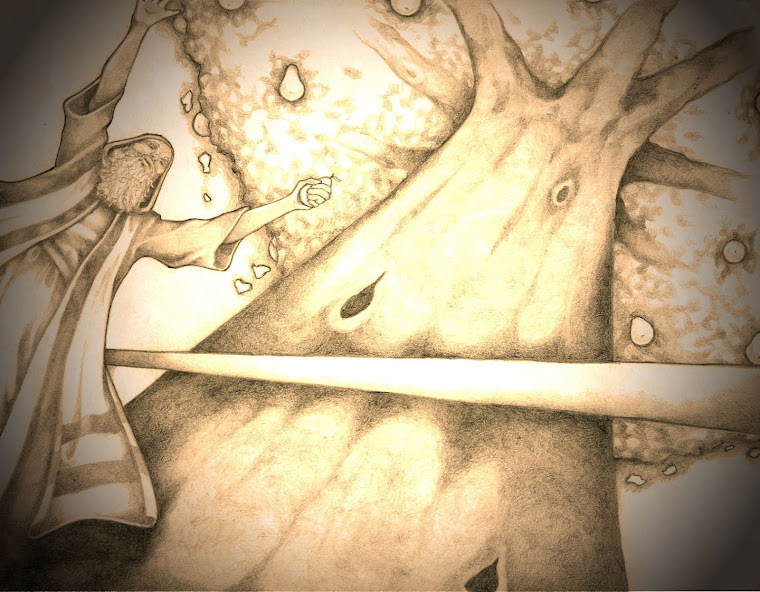 |
| Ammon before King Lamoni |
"But others rebuked them all, saying that he was a monster, who had been sent from the Nephites to torment them."
The story line is when Ammon is preaching the gospel to King Lamoni and his family and they all fall into a trance including his wife the Queen, servants as well as Ammon while either retaining a remission of their sins or being overwhelmed by the Holy Spirit. It is during this scenario that Abish a servant of the Queen draws the communities attention to what has happened in the confines of the King's home. When people gather to see what has happened many say because the King allowed Ammon a Nephite (their sworn enemies) among their community, others say it is because King Lamoni killed his servants whenever they lost his sheep at the waters of Sebus. At one point some people refer to Ammon as the Great Spirit or as someone who was sent by the Great Spirit and others referred to him as a monster that had been sent by the Nephites to torment the Lamanites. As I have mentioned numerous times in this blog, I tend to look for hints of Mesoamerica in the text of the Book of Mormon. I couldn't help but wonder if the use of the word "monster" is referring to something similar to the Mesoamerican or Mayan belief in monsters or creatures?
 |
| Actun Tunichil Muknal cave in Belize |
"Desire to be near the sacred has influenced Mesoamerican settlement. Mountains and caves were important elements in Mesoamerican creation myths. Mesoamerican belief systems link water to fertility and mountains give flowing water and rainfall through caves. Accordingly, these natural features were considered sacred and were sought out by Mesoamerican migrants looking for a new home. A cave could be considered an axis mundi if it marked the center of a village. The Late Post classic site of Mayapan incorporated several cenotes into its ceremonial groups and the Cenote Ch'en Mul is at the site core. At Dos Pilas house platforms were often in front of cave entries and the tunnel went beneath the platform."
 As noted above there were ties between these caves associated with water or cenotes that were common as a spiritual place or an axis mundi, a place where the heavens and underworld meet this world. This creating a place where the unexplained or mythical beings or creatures could be accessed. This is seen with the Hopi sacred Kachinas and the sipapuni which is a hole to the underworld. Could the Lamanites actually have held the water of Sebus as a ceremonial place or axis mundi where a deity or monster such as Ammon could surface?
As noted above there were ties between these caves associated with water or cenotes that were common as a spiritual place or an axis mundi, a place where the heavens and underworld meet this world. This creating a place where the unexplained or mythical beings or creatures could be accessed. This is seen with the Hopi sacred Kachinas and the sipapuni which is a hole to the underworld. Could the Lamanites actually have held the water of Sebus as a ceremonial place or axis mundi where a deity or monster such as Ammon could surface?The waters of Sebus were a place where the Lamanites took the kings flocks (and I suppose other Lamanite flocks) to get water and graze. It was at these waters of Sebus that Ammon first displayed deity like attributes when he slayed Lamanites who attempted to scatter the kings flocks by using only his sling and some stones. He then smote off the arms of any of those who attempted to confront him in their anger with his sword. It was such an astonishing feet that his fellow servants saved those smitten arms to display to the King as a show of Ammon's power.
"Now it was the practice of these Lamanites to stand by the waters of Sebus to scatter the flocks of the people, that thereby they might drive away many that were scattered unto their own land, it being a practice of plunder among them."
With the above referenced information I ask is it plausible that those of the community who had gathered and witnessed the things that had happened to the King and his family, including his servants and Ammon, could they be referring to Ammon as a "monster" in the sense of Mesoamerican terms of a "monster" or supernatural being who may have some association with an axis mundi at the waters of Sebus? It could make sense in a Mesoamerican setting. I suppose if we had more information about the waters of Sebus such as where it's headwaters existed (possibly from a cave or a mountain) and any other settings or uses for the waters such as a place of ceremony or sacrifice (or other games of chivalry) as cenotes were commonly used for, then we could obtain further clarification or if the use of the word "monster" were more frequently used in the Book of Mormon than we could reference this with stronger ties. Until then I offer this as an area opened for further thought and discussion.
